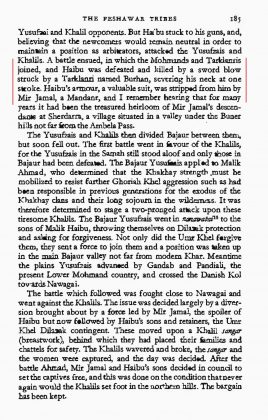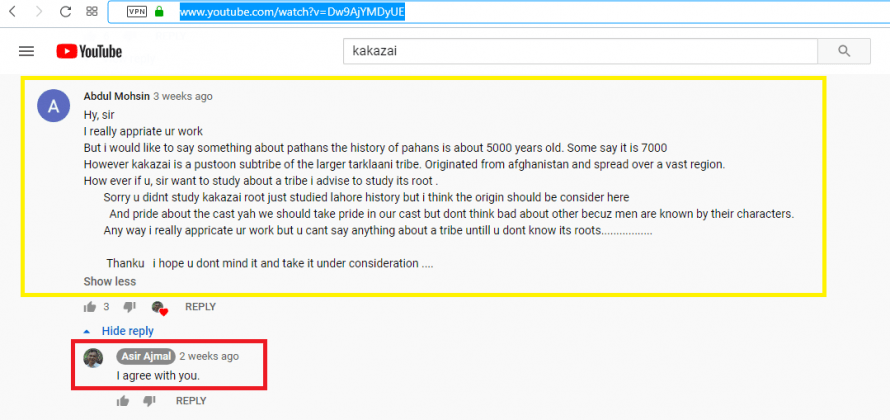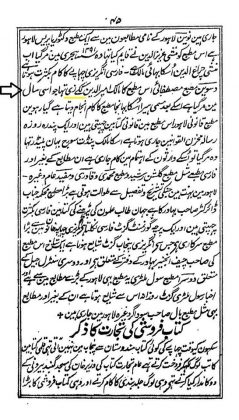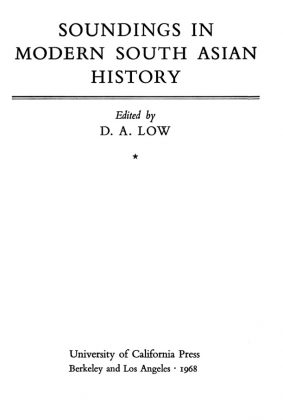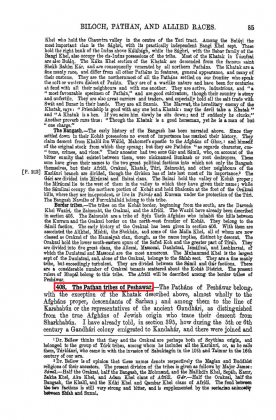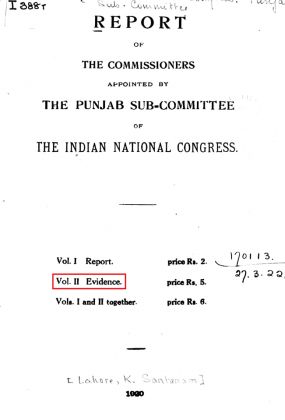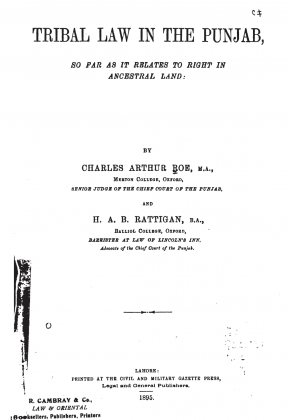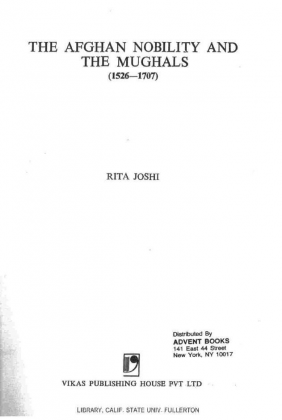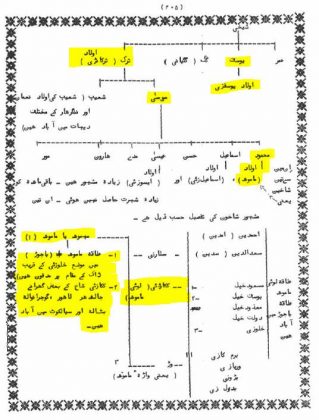
by Ali Khan ©
For the guidance of brothers and sisters living outside Khyber Pakhtunkhwa!
The Kakazai (Loi Mamund) Pashtuns of Punjab are only Pashtuns.
———
An important and sad point that needs to be clarified is that Asir Ajmal (who is a psychologist and historically, genealogists, historians and anthropologists have been tasked with identifying, researching and providing information about the origins of different communities, nations, tribes, castes, etc., not psychologists.) was never asked nor invited by anyone, from anywhere, to give his opinion or put forward any kind of “theory” about the Kakazai living in Punjab or beyond. He put forward his amateur and controversial “theory” by himself, in order to propel his own YouTube channel. In other words, he used the Kakazai of Punjab and their background or history as a sport, game, a hobby, and/or bait for his YouTube channel that he could garner more views thereby earn some cheap fame and a few bucks.
———
“Freedom of speech does not include the right nor it means freedom from consequences.” – Schenck v. the United States, 249 U.S. 47 (1919).
According to some traditions, Qais Abdul Rashid, the great-grandfather of the Pashtuns, was the first Pashtun to visit Madinah and meet our beloved Prophet Muhammad (PBUH) in person. There, he converted to Islam, and the Holy Prophet also prayed for him (in some traditions it is also mentioned that he was given a cane by the Prophet Muhammad). For this reason, he is also called a Companion of the Prophet. His holy shrine is still present in Takht-e-Sulaiman, Darazinda, Dera Ismail Khan.

Tarkalani (spelling variants include but not limited to Tarkanri, Takani, the grandfather of the Kakazai (Loi Mamund) Pashtuns (who himself was a descendant of Qais Abdul Rashid’s son, Sarban), had four sons: Mamund, Salarzai, Isozai and Ismailzai.
Mamund (whose real name was Mahmud but was known as “Mamund” (His holy shrine still exists in Mouza Daag, Tehsil Mamund, Bajaur) had two sons. The children of the eldest son are called “Kakazai” and the children of the youngest are called “Wur”, “Wara” or “Wurzai”.

The “Kaka” is respectfully used for an elder in Pashto. And “Zai” means descendants or offspring, hence “Kakazai” means the offspring or descendants of the elder son. For this reason, the Kakazai Pashtuns are also called or known as “Loi Mamund” meaning bigger or larger Mamund.
“Wur”, meaning small/little/younger in Pashto, hence “Wurzai” means the offspring or descendants of the young son. For this reason, they are also called or known as “Wur or Wara Mamund,” meaning little or smaller Mamund.
The Kakazai (Loi Mamund) Pashtuns, along-with other Pashtun tribes, came to South Asia during invasions such as those of Mahmud of Ghazni and Bahlul Lodi, settling in various regions.
The Kakazai are primarily settled in Bajaur Agency, Pakistan, but originally hailed from the Laghman province of Afghanistan. They have been settled in Punjab as early as the 1120s as well as other areas of Afghanistan and Pakistan for centuries.
Should the above map doesn’t work properly in your browser then either please click here or visit this link: https://bit.ly/3ad7ubj
Noting the martial legacy of the Kakazai (Loi Mamund) Pashtuns, Pir Moazzam Shah in his book ‘Tawareekh-e-Hafiz Rahmat Khani’ (Page 89-91 – Originally Published in 1624 AD) and Olaf Caroe in his book ‘The Pathans 550 BC-AD 1957’ (Page 184-185 – First published in 1958), wrote about a battle between the Yousafzais and the Dilazaks in which Malik Haibu (Dilazak) was given the first sword blow by Payenda Kakazai Tarklanri but eventually got beheaded by Burhan Kakazai Tarklanri sword blow while fighting on the side of the Yousafzais in order to aid them to conquer Bajour from the Dilazaks.
The names of the main or primary Khels (clans or tribal subdivisions) of the Kakazai (Loi Mamund) Pashtuns are as follows: Daulat Khel, Khulozai, Mahsud Khel, Maghdud Khel, Mahmud Khel, Umar Khel and Yusaf Khel.
According to the books of senior Pashtun, Urdu and English historians as well as in terms of meaning in Pashto, the correct spellings are “Kakazai.”
Since Pashtuns are primarily tribal, they include clans, nations, tribes and clans, but not castes. Therefore, “Kakazai” is not a caste, but a tribe.
————-
Allah says in the Noble Qur’an: “O people! We have created you from a male and a female, and made your nations and tribes that you may know one another. The most honorable of you in the sight of Allah is the one who fears most. Believe that Allah is All-Knowing, All-Aware ” (Surat al-Hujurat: 49:13). So, Allah has already created us not only in the Muhammadan Ummah of our beloved Prophet Muhammad (PBUH), but also made us a part of a respected and brave Pashtun tribe in the Pashtun ethnic tribal society of Pashtuns (with more than 49 million people, 60 major tribes and more than 400 sub-tribes) which is considered to be the largest ethnic tribal society in the world. And there is an old saying in Pashto, “Pashtun Til Pashtun Vi” which literally means something like “A Pashtun is always a Pashtun.” Thereby, Allah has also given us unity and our basic identity. He has also given us a manifesto in the form of Sunnah, Hadiths, Shari’ah, and Farewell (the last) Sermon of our beloved Holy Prophet. The Prophet (peace and blessings of Allaah be upon him) said in his Farewell Sermon: “There is no superiority of an Arab over a non-Arab and a non-Arab over an Arabic, red over black and black over red except because of piety”. Of course, the Farewell Sermon is the first and ideal manifesto of human rights. In this manifesto, the support of any group, any ethnic, national interest, any personal interest, etc., is not even mentioned. The Farewell Sermon provides the foundation for the Islamic social system. Social equality, the elimination of racial pride, the rights of women, the kind treatment of slaves, respect for each other’s lives, property and dignity are the foundations on which the social system of Islam is built. Therefore, Pashtun, post-Islam, Pashtun Wali (an ancient, pre-Islamic, hereditary, unwritten, chest-to-chest, transmitted from generation to generation, traditional, legal, moral, social Is a social system and code of conduct adorned with political, administrative and cultural rules and regulations, commonly known as the “Pashtun way of life”, the “Pashtun social way of life” or the “Pashtun social code of conduct”. Emphasis on following rules and regulations that are in harmony with the Qur’an, Sunnah and Shari’a. That is, Allah has already fulfilled all the requirements of our unity, only the responsibility to know our history and to organize ourselves, which is obligatory on every individual.
————-
Who is Asir Ajmal?
According to Muhammad Asir Ajmal’s own academic and professional resume available on the Internet, he graduated from Dartmouth College, a private college in the United States, in 1994 with a Ph.D. in Psychology in lieu of his higher education and has been teaching psychology at various educational institutions in the United States, the United Kingdom and Pakistan for the past several decades. He has British citizenship. He is based in Lahore. He plays the guitar and sings in different languages indigenous to Pakistan, which he has demonstrated in a program called “Mazaaq Raat”.
He joined the popular social networking site, YouTube, in 2011 and for the past one year he has been posting videos on his YouTube channel on the topic of indigenous psychology and other topics of psychology. But it is not known why he has started posting videos on his YouTube channel in the last few months on the communities living in Punjab, especially in Lahore, such as Rajputs, Bhatti, Arian, etc., based on their caste and their psychological attitudes and behaviors. If he had limited the information presented in his videos to his own field, namely psychology, in which he has not only higher education but also decades of experience, it would have been appropriate, but his videos about the origin and on the psychological attitudes and behaviors of these communities are becoming controversial as they are based on his personal opinions or amateurly written material (i.e. books, columns) by a particular author.
Historically, genealogists, historians and anthropologists have been tasked with identifying, researching and providing information about the origins of different communities, nations, tribes, castes, etc., not psychologists. So the videos Asir Ajmal is making and posting on YouTube on different communities based on his personal opinions, sources, hearsay or based on knowledge gained from books written by a particular columnist on different communities, nations, tribes, castes, etc. living in a particular city, or by the material or reports written by the British Raj officials on different nations, tribes, castes, etc. in order to maintain their colonialism is not only controversial and amateurish but also very sad and dangerous.
What caste or community does Asir Ajmal belong to?
Asir Ajmal considers or calls himself as Syed Makhdoom with reference to his caste or community. And as a Syed, he seems to have forgotten that the Holy Prophet Muhammad (PBUH) had said in his Farewell Sermon that there is no superiority of an Arab over a non-Arab and a non-Arab over an Arabic, red over black and black over red except out of piety. Of course, the Farewell Sermon is the first and ideal manifesto of human rights. In this manifesto, the support of any group, any ethnic, national interest, any personal interest, etc., is not even mentioned. Now let us see what is the meaning of Syed and Makhdoom.
Syed (Plural in Persian: Sadat / The plural of Syed in Arabic is Asyad or Sawa-id and the word Sadat is not used in Arabic.) literally means Sardar, which, respectfully, is reserved for the descendants of Hazrat Ali (RA) and Hazrat Fatima (RA) bint-e-Muhammad (PBUH), the word Sharif is used for them in Arabic.
The Sadat are found all over the world but most of them are found in Arab regions, Iran, Pakistan, Turkey and Central Asia. The Sadat are found in both Sunni and Shia sects. There are many types of Sadat such as Hasani Sadat, Hussaini Sadat, etc. And Makhdoom is an Arabic word meaning “teacher of the Sunnah“. It is also the title of Pir (spiritual leader) in South and Central Asia. Syed, Makhdoom or Syed Makhdoom as a nation or caste is not proven anywhere in the Quran and Sunnah or in the Arabic dictionary. Rather, these words are used only as a mark of respect. In Pakistan and India, Syed Makhdoom is used with the name of some of the religious leaders and caretakers of the saints’ shrines. Furthermore, a DNA study has clarified that most of them are self-made and so-called Syeds. See
So before presenting his controversial “theories” about others, Asir Ajmal should research what his own identity is because “Syed Makhdoom” is not a caste, a nation or a tribe.
What kind of controversial “theory” has Asir Ajmal put forward about the Kakazai (Loi Mamund) Pashtuns?
“Freedom of speech is not a license to abuse – it is a responsibility.”
—
An important and pertinent note!
Since Asir Ajmal resides in Lahore and his subject, according to his own words, are the Kakazai of Punjab and especially, the Kakazai of Lahore (Kakazai, Kakkazai, Kakayzai, etc. are just different spellings of the same tribe name. Such as Tarkani, Tarkanri, Tarkalani, etc. or Afridi, Apridi, Afrdi, etc.), it would have been better and fairer to his subjects, prior to putting forward his amateurish, baseless, unsolicited, and uninvited “theory” in his controversial videos, had he read the book, “Hidayat-e-Afghani a.k.a Tareekh-e-Kakazai Tarkani“, originally published in 1933 by Fancy Steam Press, Wazirabad, by Abul Mahmud Hidayatullah Sohdarwi (who didn’t know Pashto due to the presence of the Kakazais in Punjab for many centuries), written in the context of an era when the British were still present in the subcontinent. Although the author has made some basic mistakes in this book due to not knowing Pashto, still the author has tried his best to defend the issues facing the Kakazais of Punjab at that time. Even today it can be purchased not only from Lahore’s Urdu Bazaar but also on the internet at Daraz.pk. In addition, Asir Ajmal could have contacted the Kakazai Association, almost a century-old pre-partition association of Kakazais in Punjab, based in Lahore, for further information and research. These are just some of the basic things that you expect from a Ph.D. scholar. It is a pity that Asir Ajmal, as an educator and scholar, did not even take care of these basic things.
See the following link Abul Mahmood Hidayatullah Sohdarwi’s introduction:
http://www.bio-bibliography.com/authors/view/10404
—
Asir Ajmal’s Controversial Theory about Punjab’s Kakazi (Loi Mamund) Pashtuns
First of all, an important and sad point that needs to be clarified is that Asir Ajmal was never asked nor invited by anyone, from anywhere, to give his opinion or put forward any kind of “theory” about the Kakazai living in Punjab. He put forward his amateur and controversial “theory” by himself, in order to propel his own YouTube channel. In other words, he used the Kakazai and their background or history as a game, a hobby, and bait for his YouTube channel that he could garner more views thereby earn some cheap fame and a few bucks.
Asir Ajmal has put forward his controversial “theory” about the Kakazai (Loi Mamund) Pashtuns living in Punjab in his 3 YouTube videos. The following are only those relevant excerpts from his videos that are pertinent to the Kakazai as the rest of the irrelevant material is not the subject of this analysis, thus, they were not included in this analysis. Subsequently, screenshots of Asir Ajmal’s own comments are provided so that the reader can see for himself that what Asir Ajmal says about his own controversial theory.
Psychology & Punjabi Castes (Gujjar, Kakazai, Rajput & Syed) | Indigenous Psychology in Urdu/Hindi
Feb 7, 2019
https://www.youtube.com/embed/2DH7GofxR9o?start=640&end=841&version=3
“Speaking of Kakayzai, since the word Kakay is accompanied by the word Zai, many people think that it is a tribe, but this is not the case at all. The name Kakay is associated with the name Zai because it sounds like a Pakhtun type, a tribe. Isn’t that what you think from the name of it? No, that’s not why, the legend says that there was a Hindu personality, Karan and that Karan’s eldest son was named “Kaka” and his family was called Kakazai. Karan used to drive a chariot. He used to take care of horses. He used to take care of chariots. So Kaka is also a horse rider and took care of horses. And he also used to buy and sell horses. They are horse traders and since they are often used to buy horses, they are Kakazai, this is the family, it used to go to Central Asia, it used to go to Afghanistan, it used to go to Iran, it used to go to the Middle East. The best horses would come, then there, in Afghanistan, in Iran, to introduce themselves to other traders, where there were other tribes, Yusufzai, or Orakzai, etc., so they would say that we are Kakazai, and from here they got this name, which sounds like Pakhtun, sounds like the name of a Central Asian tribe but, in fact, it is an Indian caste. And well some people say, I have heard this from many people. That, a ridiculous claim, which shows that they have no understanding of history, they say that Kakazai came from the Sikhs. Well, now this is nonsense, because Sikhism is a recent religion, and Kakayzai is a very old caste. So it is possible that many of Kakyazis have become Sikhs, and Many people have become Muslims, and many people have remained Hindus, but it cannot be, Sir! that the Kakyzai caste is derived from Sikhs. It doesn’t make sense … So I was giving you the example of the Kakyazais because it is an interesting case study of a caste, how, for many thousands of years, this caste has been breeding within itself. At present you have in Lahore, Gujranwala, across the border, Jalandhar, Ferozepur, Hoshiarpur, there are many Kakayzai who have lived here for thousands of years, who have never married outside their caste. Coming in the generation, maybe, there are many who are getting married in different castes, I will suggest that Majid Sheikh, who has been writing many columns for a long time, also has a book, About Lahore and about the castes of Lahore, in which he introduced the Kakayzai in great detail.”
Above are Asir Ajmal’s own words, taken from his video. If you find them incoherent or disconnected, watch the video. Thank you.
Punjabi Castes & Psychology | Arain, Kakazai, Rajput, Bhatti, Marasi, Kanjar and others
Dec 7, 2019
https://www.youtube.com/watch?v=80mk3o0CCYw&t=261s
“Kakayzai was basically a sub-caste of Hindus, belonging to the Suraj Vansi or the famous Suraj family. You will be familiar with the Mahabharata story or story called the Kauravas and the Pandavas, which You could say they were cousins of each other, fighting for power. But there are very deep mystical facts in this story, and the Bhagavad Gita, which is a religious and sacred book of the Hindus, is part of the same Mahabharata story, but today’s purpose is not to talk about this holy book but to talk about the origin of the Kakazai caste. So it is said that once upon a time there was a princess named Kunti and she was the daughter of a Hindu king. And once there was a Hindu saint named Durvasa, and when Durvasa came to Kunti’s palace to meet the king, Kunti visited him very kindly, because Kunti was a very good lady, and she served this dervish a lot, and with this service, the dervish, the dervish, was so pleased that he gave a talisman to Kunti and said that when you will use/invoke this talisman, the angelic creatures who represent the sun, or those who rule over the sun, also called the sun god in Hinduism, will come and give you the good news of a child. So Kunti uses, out of curiosity, this amulet and invokes the sun god, the sun god appears and gives him an offspring, whose name, later known as Karan. Now that Kunti was unmarried, and she used this amulet out of curiosity, she had no choice but to put the baby in a basket and pour it into the river. What was special about Karan was that he was born with an armor attached to his body, and rings (drops) in his ears, so it was a sign that Karan was a great warrior. Since this child was shed and the person who discovered that child used to make chariots for the king, his house. So making chariots, riding on them was inherited to Karan, besides, he was also a very good horseman. Now Karan’s story is very long and today I don’t want to tell Karan’s story, I just want to emphasize whether it has anything to do with Kakezai’s story or Kakezai’s origin. What is it? Now Karan’s marriage, which by his adopted father (who discovered and recovered him from the water), Adirat, at his request, took place with a woman named Varushali, and now Varushali gave birth to two children, the eldest of whom was Nickname (a.k.a or nickname), he was Kaka. Now Kaka is the name that Kaka Zai how that came about, we will also talk about it. By the way, this caste was called Suraj Vansi, that it was born from a drop given by the sun and named Karan after Karan. Now Karan’s son, Kaka who is, is a descendant of Kaka because Karan was also fond of horses and he also used to raise horses, so he took up the profession of horse trade and because horses were in India, at that time, but horses were brought, from the Middle East, from Central Asia, from Afghanistan, because there were a lot of horse breeders here (in these areas), and horses were found naturally in the plains of Central Asia, and in the plains of the Middle East. So they became breeders of horses, by profession, and so when they introduced themselves, professionally, there, in those areas, when they asked “what is your tribe?” because here, in Central Asia, in these areas, there were tribes, there were no castes … So now this so-called tribe, which people say has been going on for many centuries, its main occupation was raising horses or trading horses, buying and selling horses. So for their introduction, because the Afghan tribes, like Orakzai and Achakzai, introduced themselves in the same way as Kakayzai. So you will find Kakayzai, in the areas east and west of the Indus River, you will find Kakyzai, in Afghanistan, in Central Asia, even in the Middle East. But one thing is very clear, that Kakyzai starts, the areas, which are mostly Punjab and East Punjab are their largest settlements. The descendants of Karan and Kake have their settlements. And they have been in the same (East Punjab) areas for centuries, if not thousands of years, and the later settlements that are formed are Jalandhar, Hoshiarpur, Khanpur, Gurdaspur, in all these areas, basically, there was a concentration, of Kakayzai. Anyway, in today’s video, I just wanted to emphasize that this is the origin of Kakayzai, this is from Karan, and this is what Karan is, the Suraj Vansi and as Suraj Vansi, this is the very caste that is, it belongs to a higher caste, it is not a lower caste, like a weaver, or a potter, and besides being a higher caste, it is a caste of traders, a caste of merchants…”
Above are Asir Ajmal’s own words, taken from his video. If you find them incoherent or disconnected, watch the video. Thank you.
Kakazai History | Castes of Punjab | Indigenous Psychology Urdu Hindi
Jun 9, 2019
https://www.youtube.com/embed/Dw9AjYMDyUE?start=565&end=757&version=3
“Now let’s talk about Kakayzai. Kakayzai, as I have been saying, they are very close to my heart, now these two castes, Chishti and Kakayzai, lived side by side in the Kucha Chabuk Sawaran of Lahore. Now they have lived together and they have learned a lot from each other, Chishti who are scholars, have been associated with the field of teaching, mostly, Kakayzai who are very good traders and merchants, and their business network is spread as far as Central Asia, and as I shared with you already that the main reason for using the name “Zai” is that, KaKaZai, because it is for buying and selling horses. Used to work, from Central Asia, from Afghanistan, from Iran, even from Arabia, and brought to India. Historically, they have been doing this for thousands of years, so we have to understand that. They used to talk to people in areas where people used to say that we are Yousafzai, or we are Orakzai, then they would say that we are Kakazai. But basically, as it has been researched. Yes, various researchers have said that what is “Kaka” which is, traditionally, the story is that Karan, from Mahabharata, Karan’s offspring is called “Kaka” after “Kakazai”, and their main occupation is that of horse trade and horse breeding. Majid Sheikh, who writes on Lahore, is a historian, and an expert, especially on topics related to Lahore, so he has been writing in his columns for the last several decades. And they also think that Kakazai were horse traders…”
Above are Asir Ajmal’s own words, taken from his video. If you find them incoherent or disconnected, watch the video. Thank you.
Analysis of Asir Ajmal’s controversial theory
If you have read the above texts carefully, in Urdu and English, before reaching this paragraph, with comments, then hopefully it has become clear to you that Asir Ajmal, directly and indirectly, knowingly or unknowingly, has already admitted that his controversial “theory” of the Kakazai (Loi Mamund) Pashtuns is baseless and wrong. It is also true of Asir Ajmal that he does not know Pashto, nor did he read any book on the history of the Pashtuns or the history of the Kakazis of Punjab, such as Pir Moazzam Shah’s book “Tawareekh-e-Hafiz Rahmat Khani – Afghan Tribes and Their History”, Khan Roshan Khan’s book “Tazkira: The Origin of Pathans and Their History” or Abul Mahmood Hidayatullah Sohdarawi’s book “Hidayat-e-Afghani almaroof Tareekh-e-Kakazai Tarkani”, etc. neither contacted Kakazai Association, Lahore, Punjab, several decades-old, a pre-partition association for more information and research before putting forward his controversial “theory” about the Kakazai (Loi Mamund) Pashtuns in Punjab and especially in Lahore. Because the target was not only to make them controversial but also to use them as a bait to increase views of his YouTube channel, in order to earn cheap fame as well as a few bucks.
The main source of Asar Ajmal’s theory, if considered carefully, is Majid Sheikh, who writes in English about Lahore for the daily Dawn, and has written a book about Lahore to which Asir Ajmal referred in his 1st video (“I would suggest, Majid Sheikh, who has been writing columns for a long time, also has a book about Lahore and the castes living in Lahore, in which he describes the Kakayzai in great detail.”) and the 3rd video (“Karan’s offspring is called “Kaka” and next Kaka’s offspring is called Kakayzai as their main occupation was to trade horses and raise horses, as evidenced by Majid Sheikh, who is based in Lahore. He writes about Lahore, he is a historian and is an expert, especially on topics related to Lahore, so he has been writing in his columns for the last several decades, and he also thinks that Kakayzai were horse traders.”).
So Asir Ajmal has been informed in the comments of his 3rd video (see above), with proof, that the stance, “…one source puts down their origins to the tough Cossacks of Russia that came to Lahore over 600 years ago with the Turkish invaders..”, which Majid Sheikh once took in his column written in 2004, about the Kakkayzais of Kucha Chabaksowaran of Lahore, to his credit, has been changed and updated, albeit after 13 long years but as they say “it is never too late”, with “The famous writer Olaf Caroe in “The Pathans: 550 BC-AD 1957” claims that the Kakay Zai belonged to the Loy Mamund of the Tarkani clan who were settled in the Bajaur Agency, but originally belonged to the Laghman province of Afghanistan. The first Kakayzai came to Punjab along with the invading Afghan forces of Mahmud of Ghazni between 1011 and 1021 AD. The theory “of the frontier peoples” is that when the population of tribes exceeds what their barren land can support, the enterprising among them move eastwards. They still do, these days because of wars. Makes sense, for today the old city has more Pathans than original inhabitants. So one can safely assume that some of them had moved into Punjab earlier. But there is evidence that with Mahmud a large Kakayzai group also came and settled here.” in a column he wrote in 2017. It is important to note that Majid Sheikh changed his stance but Alas! it didn’t stop Asir Ajmal using Majid Shikh’s old stance which he didn’t only repeat in three straight videos but also built a whole fairytale upon that.
As far as some of the Kakazais of Punjab being in the profession of trading or breeding of horses, there is nothing to be ashamed of as it is not only the Sunnah of our beloved Prophet (Peace and blessings of Allah be upon Him) to earn living with one’s own hands but the horses were also liked by Him and they are mentioned in the Holy Quran as well.
However, for Asir Ajmal to say, “For business conversations with people, where people used to say that we are Yusufzai, or we are Orakzai, They [the offspring of Kaka, son of Karan], used to say that we are Kakazai.” is not only odd, irrational, illogical but also it assumes that other Pashtun tribes, Yusufzai, Orakzai, etc., were also associated with only one profession, namely, horse breeding and trade, which is completely absurd in itself. How is it possible for all the people of a tribe to be associated with just one or the same profession? According to Kanhaiya Lal’s book “Tareekh-e-Lahore” (History of Lahore) published in 1884, Kakazai Muslims of Lahore were not only in book publishing or printing business but Khuda Bakhsh Kakazai was also the Kotwal of Lahore for many years.
And it is also very strange to consider the Chishti or Chishtis of the Chishtiyya chain, which is the sect of the poor and the Dervishes, as one caste.
Asir Ajmal’s secondary sources, in his own words, are the books of Denzil Ibbetson, Horace A. Rose and Edward Douglas Maclagan, “A Glossary of the Tribes and Castes of the Punjab and North-West Frontier Province“, Denzil Ibbetson’s book, “Punjab Castes“, reprinted in book form in the 1883 Census Report chapter, “The races, castes, and tribes of the people.”
————-
British colonialists conducted censuses in 1865, 1872, 1881 and 1883 to maintain their colonial rule at the hands of British civil officers during the British rule of the subcontinent and here is what Denzil Ibbetson, who was Deputy Superintendent for the 1881 census operation in Punjab and North-West Frontier Province wrote in his 1883 Report on the exercise that “Our ignorance of the customs and beliefs of the people among whom we dwell is surely in some respects a reproach to us; for not only does that ignorance deprive European science of material which it greatly needs, but it also involves a distinct loss of administrative power to ourselves.”
Having confessed that he wrote in lieu of a description of the Pathans (Pashtuns or Pakhtuns were commonly called either Afghans or Pathans, a Sanskrit word) on Page 219 of “A Glossary of the Tribes and Castes of the Punjab and North-West Frontier Province – L-Z – Volume 3” that “The true Pathan is perhaps the most barbaric of all the races with which we are brought into contact in the Punjab. His life is not so primitive as that of the gypsy tribes. But he is bloodthirsty, cruel, and vindictive in the highest degree; he does not know that truth or faith is, insomuch that the saying Afghan be iman has passed into a proverb among his neighbors; and though he is not without courage of a sort and is often curiously reckless of his life, he would scorn to face an enemy who he could stab from behind, or to meet him on equal terms if it were possible to take advantage of him, however meanly.”
With this kind of bias and prejudice against the Pashtuns and other nations, tribes, castes, races and ethnicities of the subcontinent, Denzil Ibbetson and some of his compatriots twisted and tweaked their books, census reports and other publications to favor and reward the nations, tribes, castes, races and ethnicities who supported British colonialism (i.e. British Raj) and punish the ones who were against it using the ‘stick and carrot’ and ‘divide and conquer strategy’ and thus gave rise to a new form of scientific racism and bigotry, to serve their British Imperial agenda. It took several decades for those who were affected by such excesses, corruption and deliberate misclassification of the British Raj officials to get their history and ethnicity corrected in the Government documents but the damage had been done, albeit, they stick to their guns (for example, the Pashtuns insisted on their Pashtun heritage and stood their ground) throughout the ordeal of stigmatization and deliberate miscategorization (e.g. Those tribes, nations, races, castes and ethnic groups that were considered undesirable by the virtue of not supporting the colonial rule of the British Raj, were written in official documents, census reports, etc., as their punishment either in the wrong column or simply put them in the wrong classification or mixed them with the others to create confusion) by the then British authorities). But the repercussions of the damage done to them by the British colonialists can be heard today, even decades after they left the subcontinent.
In the opinion of Crispin Bates, Modern and Contemporary South Asian history professor at Britain’s Edinburgh University, in his book, “Race, Caste and Tribe in Central India: the early origins of Indian anthropometry,” on the topic of these census reports, “….by far the least structured census ever conducted in the subcontinent and a printer’s nightmare, since rather than fit the population into pre-determined categories census takers asked relatively open-ended questions about religious beliefs and occupations. The result was a proliferation of columns concerning occupations in particular. Individuals appeared as ‘con-man’, ‘pimp’, ‘prostitute’, ‘idiot’ and ‘thief, or however else they might appear or describe themselves. Worse still, castes and tribes were listed as to whether they were ‘animist’, Christian, Hindu or Mohammedan, with little structure or system beyond the self-representation of the respondents.” Furthermore, the methods adopted by the British Raj officials, Bates wrote “…not only did [classification by occupation] allow for the possibility of unhealthily egalitarian conclusions about the ethnic mixing of the Indian population, and the possibilities for change in economic and social status, but it also directly conflicted with the racist ideas about Indian social structure that had by then been largely confirmed in the minds of administrators by more than a generation of anecdotal writing. The response was to seek for a new method that would confirm ‘scientifically’ what were now ingrained prejudices.”
————-
Some of the Kakazai Pashtuns of Punjab (at that time Pashtuns were called Pathans, a Sanskrit word for Pashtuns or Afghans because they came from Afghanistan and settled in Punjab and beyond), who settled in Punjab before 1121 AD and came to the subcontinent along with other Pashtun tribes, Niazi, Burki, Yousafzai, etc., with the forces of Mahmud Ghaznavi, Bahlol Lodhi and others, fell victim to above-mentioned ordeal at the hands of the British Raj Officials.
The Kalwar, (or Kalal, Kalar) are an Indian caste historically found in Uttar Pradesh, Rajasthan, Punjab, Haryana, and other parts of north and central India. The caste is traditionally associated with the distillation of liquor, but around the start of the 20th century assorted Kalwar caste organizations sought to leave that trade and redefine their community. Because their hereditary occupation of distilling and selling liquor was considered degrading, the Kalals held a very low status and were relegated to the status of traditional caste hierarchy in South Asia. Thus, some of them converted to Sikhism (which is a new religion compared to Islam, while the Pashtuns have been Muslims since the time of Qais Abdul Rashid) and some converted to Islam.
The situation of the Kalals who converted to Sikhism (i.e. Sikh Kalals) changed when their chief, Jassa Singh Kalal, rose to political power in the 18th century. Jassa Singh styled himself as Ahluwalia after the name of his native village, Ahlu, and established the ruling dynasty of the Kapurthala State. After the rise of Jassa Singh Kalal, other Sikh Kalals also adopted Ahluwalia as the name of their caste, and began to abandon their hereditary and traditional profession. Regulations on the production and sale of wine imposed by the colonial British administration accelerated this process, and by the early 20th century, most Kalals had abandoned their hereditary and traditional occupations. By this time, the Ahluwalias had begun to claim to be Khatris or Rajputs in order to enhance their social status.
The Kalals, who converted to Islam (i.e. Muslim Kalals), following in the footsteps of the Kalals who converted to Sikhism (i.e. Sikh Kalals), elevated their social status by adopting the Pashtun identity of the Kakazai (Loi Mamund) Pashtuns who were already present in Punjab for centuries. Some of these Kalal-turned-Kakezais, such as the Hoshiarpur family that ruled the Jalandhar Doab in the 1840s, further raised their status by claiming to be high-caste Shaikhs. Like the Sikh Kalals, some Muslim Kalals also claimed Khatri or Rajput origin. In the 1890s, Kalwars in Allahabad were claiming themselves to be of the Kshatriya status.
————-
In the decades when the Pashtun tribes in the northwestern province of British Raj (now Khyber Pakhtunkhwa) were fighting to defend and protect their territory against British colonialism in different parts of the province, the residents of Mamund Valley, Kakazai (Loi Mamund) tribe and his younger brother, Wara Mamund tribe were defending theirs in Mamund Valley (named after Mamund, the Father of Kakazai Pashtuns, whose ancient name is Watelai Valley.), Bajaur, whose moments of bravery were captured by Winston Churchill in his books “The Story of Malakand Field Force” as “…it would be unjust and ungenerous to deny to the people of the Mamund [the spelling then used] Valley, that reputation for courage, tactical skill and marksmen which they have so well deserved. During an indefinite period they had brawled and fought, in the unpenetrated gloom of barbarism. At length they struck a blow at civilisation, and civilisation will yet ungrudgingly admit that they are a brave and warlike race. Their name will live in the minds of men for some years, even in this busy century, and there are families in England who will never forget it.” — Winston Churchill, The story of the Malakand field force: an episode of frontier war by Winston Churchill, b 1874 – d 1965 (Page 274)
Denzil Ibbetson, and his fellow British Raj officers, in some of their census reports and its columns, not only listed the Kalal-turned-Kakezais with the Kakazai (Loi Mamund) Afghan Pathans (i.e. Pashtuns, Pakhtuns), who had lived in Punjab for centuries since 1120s AD but also tried to justify it further in the summary by writing that these Kakazai (Loi Mamund) were originally Kalals and after became “Kakezai” to elevate their social status although the facts were totally the opposite.
These mistakes, errors, miscategorizations or whatever one calls it, intentional or unintentional or due to lack of knowledge on the part of British Raj officials about the Kakazai (Loi Mamund) Pashtuns’ presence in Punjab for centuries, however, led to a plethora of mistakes when Denzil Ibbetson, Horace Arthur Rose (H.A. Rose) and Edward Douglas Maclagan repeated them in their subsequent books (i.e. “A Dictionary of the Tribes and Castes of the Province of Punjab and the North-West Frontier Province”, by Denzil Ibbetson, “The Punjab Castes”, being a reprint of the chapter on “The races, castes, and tribes of the people” in the report on the census of the Panjab) and other authors rehashed them by quoting and solely relying upon the content of the census reports and other material authored and produced by above-mentioned British Raj official without further investigation, research or due diligence.
An important and noteworthy aspect of this whole ordeal faced by the Kakazai (Loi Mamund) Pashtuns of Punjab is that quite ironically Denzil Ibbetson, Horace Arthur Rose (H.A. Rose) and Edward Douglas McLagan did not only mention the Tarklani, grandfather of Kakazai (Loi Mamund) Pashtuns, in their books, “A Glossary of the Tribes and Castes of the Punjab and North-West Frontier Province – LZ – Volume 3 – on pages 249-250 and Denzil Ibbetson in his book “Panjab Castes” on pages 70-71 and 86-80, but also published a number of Family Trees – albeit incorrect – thereby contradicting themselves and admitting, indirectly, that Kakazai Pashtuns of Punjab are, in fact, Pathan or Afghan.
—
If we consider the Kakazai of Punjab only, then the following books published during the British Raj era acknowledge their existence in Punjab:
“Handbook of the Manufactures And Arts of the Punjab – With A Combined Glossary And Index of Vernacular Traders and Technical Terms, & c., & C. – Forming Vol. II – To The “Handbook of The Econocim Products of the Punjab” – Prepared Under the Order of Government by Baden Henry Baden-Powell (HM Bengal Civil Service) ”- Page 78 and 79
Acknowledges Kakazai Traders in Sialkot (spelled as ‘Sealkot’) and as far as Peshawar
(Originally Published in 1872)
—
“Customary Law of the Gujrat District” – Volume IX – by Captain H. Davies (Settlement Officer) – Page 2
Acknowledgments of the Kakazai Tribe in Gujrat, Kharian and, Phalia
(Originally Published in 1892)
—
“The Cyclopedia of India and of Eastern and Southern Asia” – by Edward Balfour (Page 655) – Originally Publish in 1885 ::
Acknowledges the Kakazai Pashtuns in Lahore
—
“Report of the Commissioners Appointed by the Punjab Sub-Committee of the Indian National Congress, Indian National Congress. Punjab Subcommittee ”- Volum II – Evidence – Page 290, 291, 292 and more
Acknowledgments Kakazai, Kucha Kakazaian and Kakazaian Street in Lahore
(Originally Published in 1920)
—
“Tribal Law in the Punjab – So Far As It Relates To Right In Ancestral Land” – by Charles Arthur Roe (Senior Judge of the Chief Court of the Punjab) and HA Rattigan (Barrister At Law of Lincoln’s Inn) :: Page 46, 68, 75
Acknowledges the Kakazai in Sialkot, Pasrur and other places (Originally Published in 1895)
—
“The Afghan Nobility and the Mughals: 1526-1707” – by Rita Joshi – Page 9 – Vikas Publ. House, New Delhi, India. ISBN 978-0706927528.
More references in Pashto, Urdu and English about the Kakazai (Loi Mamund) Pashtuns are available at this link.
It is noteworthy that not only has a DNA study been conducted on the Kakazai (Loi Mamund) Pashtuns, along with some other Pashtun tribes, but also a Ph.D. thesis mentions the background of the Kakazai Pashtuns in Punjab.
However, in order to rectify these errors in the official documents, the Kakazai of Punjab approached the courts and eventually rectified it. The protagonists of the story of all these struggles, the Kakazai, who fought for their rights in the courts of the British colonialists are not alive, but their descendants are still in Punjab to witness the struggle of their elders. Some of its records are still available in the Kakazai Association of Lahore, which is one of the oldest Kakazai Association in Pakistan and Punjab and was founded before the formation of Pakistan during the British Raj era. Parts of the story of this struggle were narrated by Abul Mahmud Hidayatullah Sohdarawi (who was unfamiliar with Pashto due to the presence of Kakazis in Punjab for many centuries) in his book “Hidayt-e-Afghani, popularly known as Tareekh-e-Kakazai Tarkani”, published in 1933. Although the direct British Raj over the subcontinent is over, the repercussions and echos of their mistakes are still heard today, sometimes from our own people such as Asir Ajmal or from foreigners in their books, videos, etc.
Conclusion
“Your Liberty To Swing Your Fist Ends Just Where My Nose Begins.”
After reading the above paragraphs, comments and seeing all the references, hopefully, it will be clear to the readers that it is not the Kakazai / Kakayzai of Punjab who fabricated the myth or cooked up facts of “We are Afghans (Pathans / Pashtuns / Pakhtuns)”. Yet, it is Asir Ajmal himself who, using his wildest stretch of the imagination, has fabricated a common myth and cooked up a fairytale about Kakazais of Punjab, from Karan to Kaka and then from Kaka to Kakazai or Kakayzai being a Hindu, which has no reality and no logic. As a Muslim, it should be more honorable and grateful for us that Allah Almighty has created us in the Ummah of Muhammad (PBUH) than “we are Afghans”, “we are Arabs” etc. It is worth mentioning that the Kakazai (Loi Mamund), along with some other Pashtun tribes, have not only undergone DNA study but also the background of Kakazai Pashtuns of Punjab has been mentioned in a Ph.D. dissertation, in addition to all the references from the historical books mentioned above, the University of Peshawar.
All the ground realities, from the presence of the tomb of Pashtuns’ ancestor, Qais Abdul Rashid, in Darazinda, Dera Ismail Khan to the tomb of Mamund (whose real name was Mahmood), Father of Kakazai (Loi Mamund) Pashtuns in Daag, Bajaur, from the presence of Pashto-speaking Kakazai (Loi Mamund) Pashtuns in different parts of Afghanistan, Pakistan and Khyber Pakhtunkhwa even today, to documentary facts such as the references of Tarkalani, Grandfather of Kakazai (Loi Mamund) Pashtuns in “A Glossary of the Tribes and Castes of the Punjab and North-West Frontier Province” – LZ – Volume 3 – on pages 249-250 and Denzil Ibbetson in his book “Panjab Castes” on pages 70-71 and 86-80, along with the family trees, albeit incorrect ones, as if to deny one’s own writings, from other books mentioning about the presence of Kakazai Pashtuns in Punjab for many centuries by other British authors to repeatedly commentators telling Asir Ajmal through their comments on all of his three videos that he is wrong, etc., and he agreeing to that all confirm that Asir Ajmal is categorically wrong about the origin of the Kakazai (Loi Mamund) all over the world including Punjab. By deliberately posting, keeping and rehashing the same stances which have been reversed by their original authors in these videos on his YouTube channel, Asir Ajmal is not only ridiculing, maligning and in contempt to all the Kakazai living in the world (including Punjab, Khyber Pakhtunkhwa, Pakistan, Afghanistan) but also all the Pashtuns in general. Now only Asir Ajmal knows whether it is the intoxication of his Ph.D. or the arrogance of having British citizenship, it is his egoism or the lust for cheap fame that has stopped him from removing his fictional and contemptuous videos from his YouTube channel despite knowing all the facts. Whatever it is, he must remember that truth always and ultimately prevails.
© www.kakazai.com
#asirajmal #Psychology #psychotherapy #asirajmal, #Psychology, #psychotherapy, #hypnotherapy, #psychotherapy
Psychology & Punjabi Castes (Gujjar, Kakazai, Rajput & Syed) | Indigneous Psychology in Urdu/Hindi





